Textured art heals through touch alone because your mechanoreceptors activate multiple brain regions, releasing neurotransmitters that reduce stress hormones while promoting emotional regulation. When you engage with malleable materials like clay or fabric, you’re creating a direct pathway between physical sensations and emotional expression, bypassing verbal processing limitations. This tactile interaction calms your nervous system, builds neuroplasticity, and provides immediate sensory feedback that reveals buried emotions. Discover how different textures might transform your own healing journey.
The Neurological Power of Tactile Sensations in Art Therapy
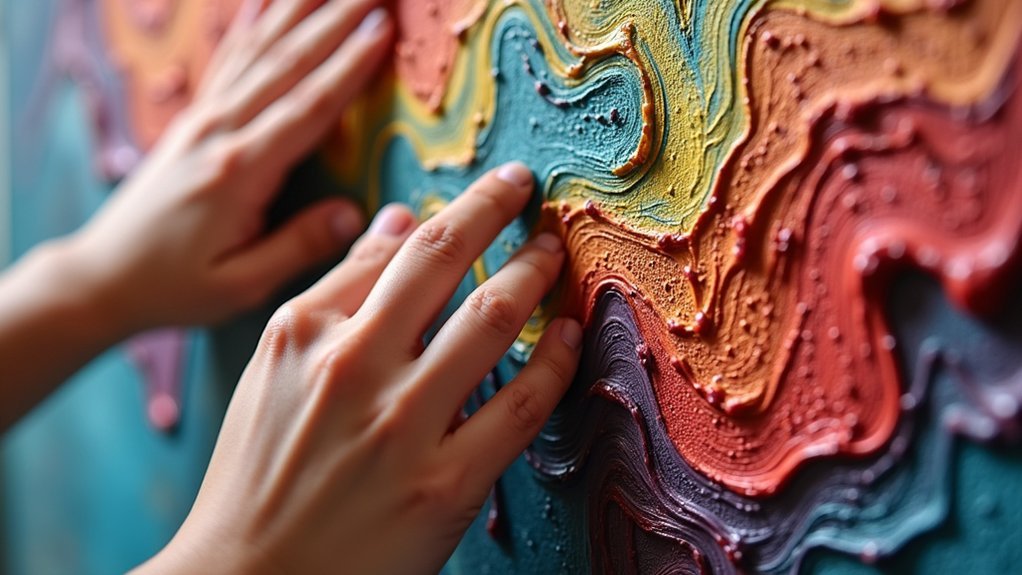
When we engage with textured art materials, our brains light up in remarkable ways. Touch receptors in your skin send signals that activate multiple brain regions, triggering both sensory processing centers and emotional regulation systems simultaneously. Art therapy facilitates this process by engaging visual and tactile sensory inputs that become integrated with emotional and cognitive processing.
This cross-modal integration—where touch and vision work together—enhances your cognitive and emotional functioning.
What’s happening beneath the surface is fascinating: your brainstem regulates bodily awareness while your limbic system processes emotions tied to traumatic memories. The cerebral cortex engages in higher-order thinking as you interpret what you’re creating.
This neurological symphony promotes neuroplasticity—your brain’s ability to reorganize itself—while stimulating neurotransmitter release associated with relaxation. You’ll likely experience reduced cortisol levels, explaining why tactile art therapy can be so effective for anxiety reduction and trauma processing.
Exploring Emotional Release Through Textured Materials
When you work with clay, fabric, or textured paint, you’re engaging your brain’s trauma processing pathways through meaningful touch.
Materials that can be molded, torn, or transformed become powerful conduits for expressing emotions that might otherwise remain trapped.
Your hands’ interaction with textured art materials creates a direct channel between physical sensation and emotional release, allowing feelings to transform from abstract distress into tangible, manageable forms. This process honors how emotions often manifest as physical sensations in the body, creating a bridge between inner experience and external expression.
Tactile Trauma Processing
Deep within the human nervous system lies an intricate network of mechanoreceptors that respond to textured materials, offering a powerful pathway for trauma processing.
When you engage with tactile art, your brain begins a remarkable healing journey as your fingers trace different surfaces, helping release emotional blockages stored in your body.
- Your amygdala’s fear response gradually calms as textured materials activate your parasympathetic system
- Each unique texture speaks to your thalamus differently, bypassing verbal processing limitations
- Trust builds through safe, self-directed touch experiences at your own pace
- Your default mode network shifts, allowing reintegration of fragmented memories
- Neuroplasticity occurs with consistent tactile engagement, creating new neural pathways
This sensory-based approach proves especially valuable when traditional talk therapies hit roadblocks, as trauma often lives in body sensations rather than conscious thought. This approach aligns with research showing touch therapy significantly increases oxytocin release, promoting feelings of safety and connection crucial for trauma recovery.
Malleable Materials Matter
Malleable materials offer you a unique gateway to emotional liberation that rigid art forms simply can’t match. When you work with clay, play-dough, or fabric, you’re engaging in a tactile conversation with your emotions, physically reshaping your feelings into tangible forms.
These pliable mediums provide immediate sensory feedback as you push, pull, and transform them. You’ll notice your stress levels decreasing while your mind enters a state of focused flow. The act of molding something with your hands engages multiple senses simultaneously, triggering a relaxation response that soothes your nervous system. This tactile engagement functions as a non-verbal communication form that allows expression without requiring words.
Research confirms that this physical manipulation of materials helps you regulate emotions that might otherwise remain locked inside. It’s why art therapists consistently turn to malleable materials for treating anxiety, depression, and trauma.
Touch Transforms Emotions
The transformative power of touch lies at the core of emotional healing through textured art. When you engage with textured materials, your brain forms connections between physical sensations and emotional memories, activating your prefrontal cortex and amygdala—key regions for emotional processing. Art therapy promotes the activation and reintegration of the self through creative expression involving tactile sensations.
- Your fingertips detect subtle variations in texture, triggering emotional responses tied to past experiences.
- Working with diverse materials (fabric, wood, stone) opens different emotional pathways and expressions.
- The physical act of manipulating textured art provides a safe outlet for suppressed emotions.
- Your brain’s neuroplasticity allows new neural pathways to form through repeated tactile art experiences.
- Engaging with textured art activates both emotional and sensory systems, creating a holistic healing experience.
Clay Work: A Grounding Experience for Sensory Processing
Clay work offers a uniquely grounding experience for individuals seeking sensory regulation and emotional balance. When you touch clay, you’re engaging in a multisensory experience that activates your olfactory, tactile, and temperature senses simultaneously.
The earthy smell triggers primal connections to nature, while your hands experience the cool, malleable texture that responds to your every movement. This sensory engagement shifts your brain wave frequencies, particularly increasing gamma waves associated with higher cognitive processing.
You’ll notice anxiety diminishing as your focus narrows to the material in your hands. For those managing hyperactivity or stress, clay provides a controlled outlet for energy while promoting relaxation. The calming environment created through clay work helps maintain composure and concentration even during extended periods of engagement.
The physical manipulation of clay enhances motor skills while offering a tangible medium for emotional expression and memory processing.
Adaptive Art Tools for Varying Physical Abilities
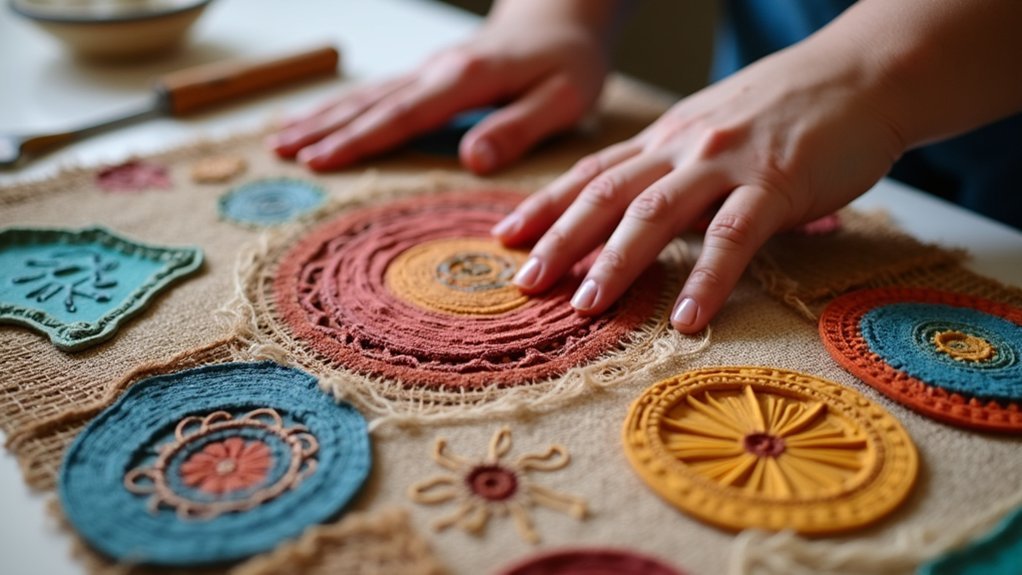
Adaptive art tools have revolutionized creative expression by removing barriers that once limited artistic participation for individuals with diverse physical abilities. These innovative tools open worlds of creativity, offering independence while addressing mobility and accessibility challenges that often prevent artistic engagement. The development of adaptive tools actively champions inclusive environments for those with different accessibility needs.
- Modified instruments with grip aids help artists with limited dexterity create beautiful works.
- Digital assistive technologies, including eye-gaze tracking, enable hands-free artistic creation.
- Sensory integration tools with textured materials enhance the artistic experience.
- Environmental adaptations guarantee comfortable workspace accessibility.
- Communication devices facilitate artistic expression for those with speech limitations.
You’ll find these tools not only promote self-expression but also provide significant cognitive and physical benefits.
When implemented with professional support and proper training, adaptive art tools become powerful instruments for boosting self-esteem while fostering social connections through collaborative creative experiences.
Fostering Self-Expression Without Visual Feedback
When creating without visual feedback, artists engage in a profound journey of self-expression that transcends traditional artistic boundaries. You’ll discover that textured art provides a unique platform for emotional release where your fingers become your eyes. Material-based art enables a powerful connection where material physicality activates bodily senses and can unlock buried memories.
| Sensory Experience | Emotional Outcome |
|---|---|
| Pressing clay | Releasing tension |
| Weaving textures | Building confidence |
| Sculpting forms | Processing complex emotions |
| Layering materials | Achieving mindfulness |
This approach empowers you regardless of visual ability, creating an inclusive creative space where your thoughts transform directly into tangible expression. The therapeutic benefits emerge as you channel emotions through touch, fostering mindfulness and emotional processing. You’ll find yourself fully present in the tactile moment, developing sensorimotor skills while experiencing the freedom that comes with creating art that speaks through sensation rather than sight.
Building Confidence Through Tangible Creative Achievements
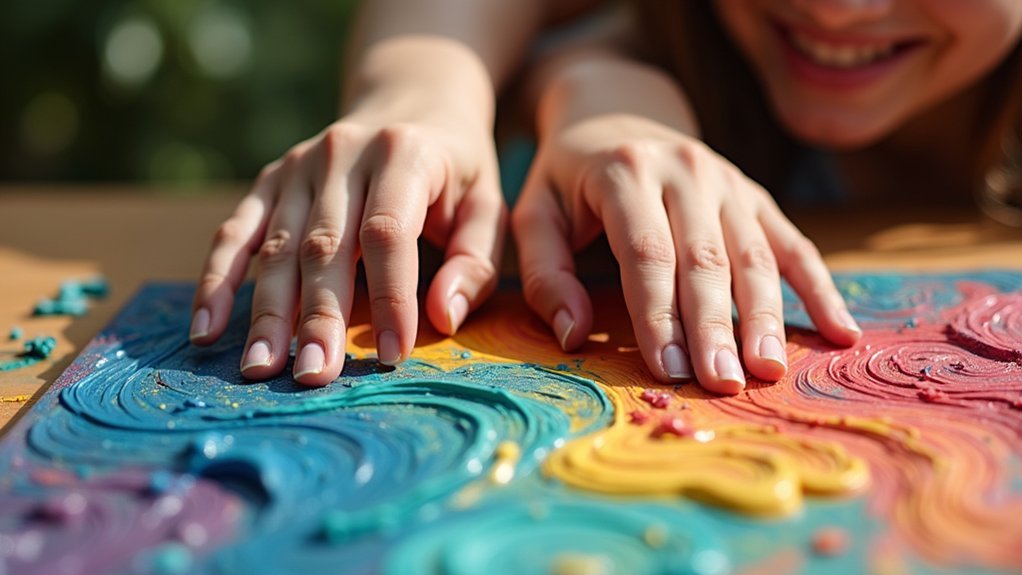
As you engage with textured art, the physical nature of your creations offers a powerful pathway to self-confidence that’s uniquely satisfying.
You’ll experience immediate, tactile feedback from your efforts, building a sense of accomplishment that visual art alone can’t provide.
- Touch-based creation empowers you by producing tangible results you can feel and explore
- Working with diverse materials enhances your sensory perception and manual dexterity
- Overcoming textural challenges develops patience and persistence that transfer to other areas
- Open-ended exploration allows for success without rigid expectations of “correctness”
- Regular practice builds familiarity with techniques, leading to greater artistic confidence
This tangible evidence of your abilities—something you can literally hold in your hands—reinforces your creative identity and validates your artistic choices in a profoundly personal way. Artists have long understood that material properties in artwork reveal unique texture summary statistics that our brains instantly recognize, creating a deeper connection to the piece.
Textured Collage Techniques for Emotional Regulation
Textured collage offers you a powerful medium for processing complex emotions through the deliberate selection and arrangement of tactile materials.
You’ll find that engaging with various textures can have a remarkably calming effect on your nervous system as you physically interact with the materials.
The structured nature of collage creation provides you with a sense of control that enhances emotional regulation while creating a tangible representation of your feelings.
This creative approach is particularly beneficial for individuals with ASD, as it facilitates sensory integration skills through the exploration of diverse art materials.
Texture’s Calming Effects
The profound impact of texture on our emotional well-being extends far beyond simple aesthetic appreciation. When you engage with different textures, your brain receives sensory stimulation that can markedly reduce anxiety and promote a sense of grounding in the present moment.
Research supports how tactile experiences directly influence your emotional states:
- Touching varied materials activates mindfulness, pulling your attention away from distressing thoughts.
- The repetitive nature of working with textured materials creates a meditative state, calming your nervous system.
- Your amygdala responds to tactile sensations, helping regulate emotional responses.
- Sensory diversity in collage work engages multiple brain regions, enhancing emotional processing.
- Texture-based art provides a concrete way to express and process complex emotions that might be difficult to verbalize.
Creating textured collages can be especially valuable as they enable the exploration of deeper metaphors that reveal insights not accessible through traditional verbal exercises.
Collage for Processing Emotions
Collage art stands as a remarkable medium for emotional processing, combining the sensory power of textures with creative expression.
When you create a textured collage, you’re engaging both visual and tactile senses, enhancing your emotional awareness through physical interaction with materials. This immersive process helps individuals reconnect with their bodies, addressing the somatic disconnection often experienced after trauma.
You’ll find that selecting and arranging textured elements becomes a metaphorical representation of your inner experiences. This tactile process gives you creative control and agency, critical components for emotional regulation.
As you tear, cut, and adhere materials, you’re symbolically organizing fragmented emotions into a cohesive narrative.
For many, especially those processing trauma or anxiety, textured collage work offers a non-verbal pathway to express what words cannot.
The multi-sensory engagement strengthens mind-body connections, ultimately building resilience and providing therapeutic benefits that extend beyond the art-making session.
The Role of Hand-Brain Connection in Mental Healing
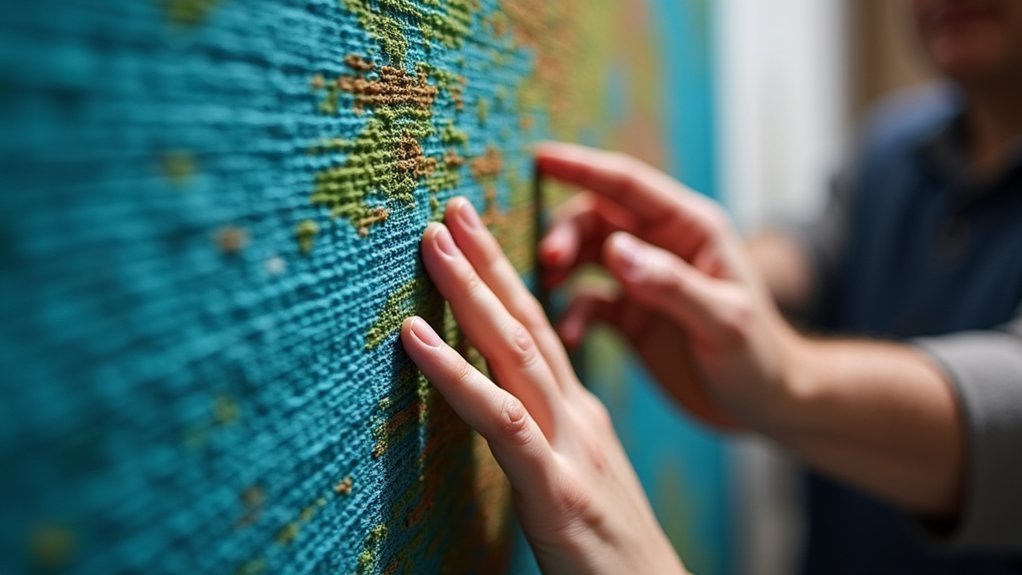
When your hands engage in creative work, they establish a powerful neurological connection that greatly benefits mental health and healing processes. This hand-brain pathway activates multiple brain regions simultaneously, enhancing neural connectivity and promoting emotional release. These tactile activities trigger effort-driven rewards that significantly contribute to improved emotional well-being, as noted in Kelly Lambert’s research.
- You’ll experience reduced anxiety and depression symptoms as you physically manipulate textured materials.
- Your brain forms new neural pathways during tactile creation, improving cognitive processing.
- Working with your hands enhances mindfulness, keeping you present and focused.
- The sense of accomplishment from creating something tangible boosts your self-esteem.
- Tactile feedback from various textures provides sensory stimulation that can comfort and ground you.
This neurological relationship explains why hand-based creative therapies are so effective for emotional healing and why simply touching textured art can initiate healing responses in your brain.
Creating Accessible Art Spaces for Diverse Abilities
You’ll find that multisensory inclusive environments transform art spaces into healing sanctuaries for people with diverse abilities.
Tactile navigation systems provide independence and dignity, allowing visitors to explore galleries without barriers or assistance.
When selecting materials for exhibits, choosing adaptive options like thermoform diagrams, textured surfaces, and variable-height installations guarantees everyone can connect with art’s therapeutic power.
Universal Design principles enhance accessibility for all visitors by creating inclusive environments that accommodate various sensory processing needs and learning styles.
Multisensory Inclusive Environments
Modern art spaces have evolved beyond traditional visual galleries to embrace multisensory inclusivity that serves everyone, regardless of ability.
These environments engage all your senses, creating immersive experiences that both enhance well-being and break down accessibility barriers. The shift toward multisensory engagement represents a return to historical museum practices that existed prior to the 19th century.
- Touch-based interfaces and tactile feedback systems allow you to “see” art through your fingertips.
- Strategic spatial organization reduces sensory overload while optimizing information processing.
- Audio descriptions and sound elements provide alternative channels for experiencing visual works.
- Interactive digital installations adapt to your individual sensory preferences and abilities.
- Sensory substitution technologies translate visual elements into alternative formats you can process through different senses.
When you encounter these thoughtfully designed spaces, you’re experiencing an evidence-based approach to inclusivity that improves engagement, learning, and psychological well-being for visitors across all ability levels.
Tactile Navigation Systems
Tactile navigation systems have revolutionized accessibility in art spaces by enabling visitors with diverse abilities to independently explore and engage with exhibitions. These systems combine touch-based floor plans with audio feedback, creating mental maps that guide you through complex gallery spaces.
Despite COVID-19 pushing towards contactless solutions, tactile elements remain fundamental for visually impaired visitors. You’ll find innovative approaches like stackable maps for multi-story museums and integrated Braille signage throughout these spaces. Museums are increasingly incorporating phygital experiences that blend physical interaction with digital convenience to create more inclusive environments.
The future merges traditional tactile approaches with digital enhancements—smartphones, augmented reality, and touch-sensitive displays now complement physical navigation aids. These technologies personalize your experience while maintaining vital tactile elements.
When implemented through user-centered design and regular feedback loops, these systems transform art spaces from merely viewable to fully explorable for everyone.
Adaptive Material Selection
Beyond navigation systems, the heart of accessible art spaces beats within thoughtful material selection.
You’ll find that well-chosen materials dramatically improve accessibility for artists and visitors with diverse abilities.
When selecting materials for your accessible art space, consider:
- Variable texture surfaces that enhance tactile engagement for all participants
- Adaptive art tools like modified brushes that accommodate different physical abilities
- Materials that are easy to manipulate, supporting independent creativity
- Elements that provide sensory integration through fabric, wood, or metal
- Adaptive seating and display systems with adjustable heights
These thoughtful material choices transform standard art spaces into inclusive environments where everyone can create and appreciate art. Organizing supplies in buckets or baskets with adapted tools provides easy access for students with different mobility and cognitive needs.
Sensory Engagement as a Path to Mindfulness
The profound connection between sensory experiences and mindfulness offers a compelling pathway to enhanced well-being and psychological health. When you engage with textured art, you’re activating multiple sensory channels simultaneously, anchoring yourself firmly in the present moment. Research shows that practicing this form of mindfulness can lead to reduced perceived stress while simultaneously improving work engagement.
Your brain responds physiologically to this sensory stimulation, with measurable changes in heart rate variability indicating increased relaxation and parasympathetic activity. This engagement isn’t merely pleasant—it’s transformative, as regular practice leads to neuroplastic changes that enhance your attention and sensory processing capabilities.
Technology now extends these benefits through interactive platforms and biofeedback tools that deepen your mindfulness practice. By focusing on the tactile sensations of textured art, you’re training your mind to reduce emotional reactivity while improving your capacity for sustained attention and awareness.
Success Stories: Transformation Through Touch-Based Art
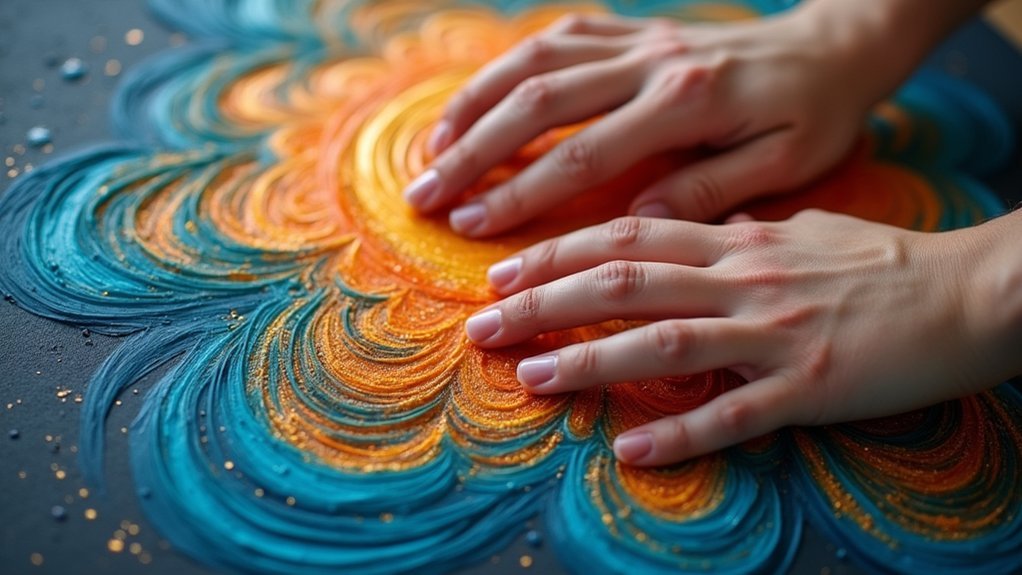
When individuals engage with textured art as a therapeutic medium, they often experience profound personal transformations that extend far beyond aesthetic appreciation.
These tactile experiences create pathways to healing that traditional talk therapy alone can’t achieve.
- Veterans with PTSD, like John, translate trauma into visual art, processing emotions they couldn’t verbalize.
- Children escaping violence find stability through textile arts, literally stitching fragmented experiences together.
- Anxiety levels measurably decrease in older adults who participate in touch painting interventions.
- Visually impaired students develop improved fine motor skills and social confidence through tactile art therapy.
- Hospice patients create legacy pieces through textured art, providing emotional connection for grieving families.
You’ll find that touch-based art modalities consistently bypass verbal barriers, making them powerful tools for those struggling with trauma or communication difficulties. Even individuals with advanced dementia, who are largely non-verbal, can express themselves meaningfully through guided art making with textured materials.
Designing Multi-Sensory Art Therapy Sessions
Creating effective multi-sensory art therapy sessions requires careful attention to both scientific principles and individual client needs.
You’ll want to leverage neuroplasticity and sensory integration theory when selecting art mediums for your clients, especially children aged seven to fourteen from diverse backgrounds.
Balance structured and unstructured activities to facilitate different therapeutic experiences. Clay work offers particularly rich sensory benefits through touch and manipulation. Remember that even clients who struggle with verbal check-ins can express emotions through these tactile experiences. Research supports that engaging with textured art can provide restorative benefits similar to experiencing nature environments.
Consider how different stimuli produce various effects—some calming, others activating. Your sessions should run several weeks to guarantee therapeutic impact, with activities tailored to each client’s sensory processing needs.
When designed thoughtfully, these sessions enhance emotional well-being while supporting cognitive and developmental growth.
Developing Personalized Tactile Art Therapy Plans
Personalized tactile art therapy plans build upon the multi-sensory foundation we’ve established, focusing specifically on individualized touch experiences for ideal therapeutic outcomes.
Tailoring tactile experiences to each client’s sensory profile unlocks profound therapeutic potential through personalized touch-based art.
When you develop these plans, consider your client’s unique sensory profile and tactile preferences to maximize engagement and therapeutic benefit.
- Begin with material exploration sessions to identify which textures resonate most with your client.
- Use sensory profiling assessments to document responses to different tactile stimuli.
- Match materials to therapeutic goals—clay for emotional expression, sandpaper for processing difficult emotions.
- Adjust tactile intensity based on your client’s comfort zone, gradually boundaries.
- Document and track progress through tactile preferences, noting how material choices shift as healing occurs.
This personalized approach guarantees clients connect deeply with their therapy process, offering a judgment-free way to express emotions without verbal explanation, leading to more significant breakthroughs and lasting healing outcomes.
Frequently Asked Questions
How Does Textured Art Therapy Differ for Congenital Versus Acquired Blindness?
You’ll find textured art therapy differs as congenitally blind individuals rely on intuitive tactile senses, while those with acquired blindness process through visual memories, requiring different approaches in adaptation and expression.
Can Textured Art Therapy Benefit People With Dementia?
Yes, textured art therapy can greatly benefit you if you have dementia. You’ll experience cognitive stimulation, memory triggering, stress reduction, and emotional expression opportunities as you engage with diverse textures through tactile exploration.
What Qualifications Are Needed to Practice Tactile Art Therapy?
You’ll need a master’s degree in art therapy, 700 supervised practicum hours, and proper certification (ATR). You should also pursue specialized training in tactile techniques and maintain ongoing professional development to practice effectively.
How Do Insurance Companies Typically Cover Tactile Art Therapy?
Insurance companies typically cover tactile art therapy if you have a medical necessity referral. You’ll need a licensed therapist with proper certifications. Coverage varies by location and insurer, with usual copays applying.
Can Textured Art Therapy Be Effectively Conducted Through Telehealth?
Yes, you can effectively engage in textured art therapy via telehealth. Research shows it builds strong rapport, may reduce resistance, and empowers you to create art in your home environment with proper materials and guidance.
In Summary
You’re not just creating art—you’re healing through your fingertips. When you engage with textured materials, you’re activating neural pathways that bypass visual processing and connect directly to emotional centers. Whether you’re working with clay, fabric, or adaptive tools, you’re practicing mindfulness and self-expression simultaneously. Your hands remember what your mind sometimes forgets, making tactile art therapy a powerful path to recovery and discovery.

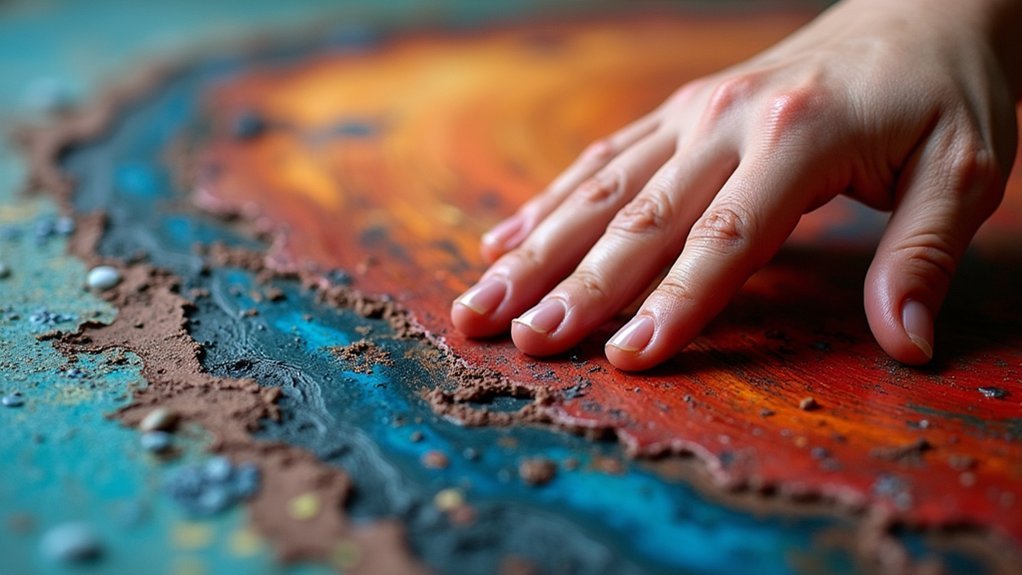

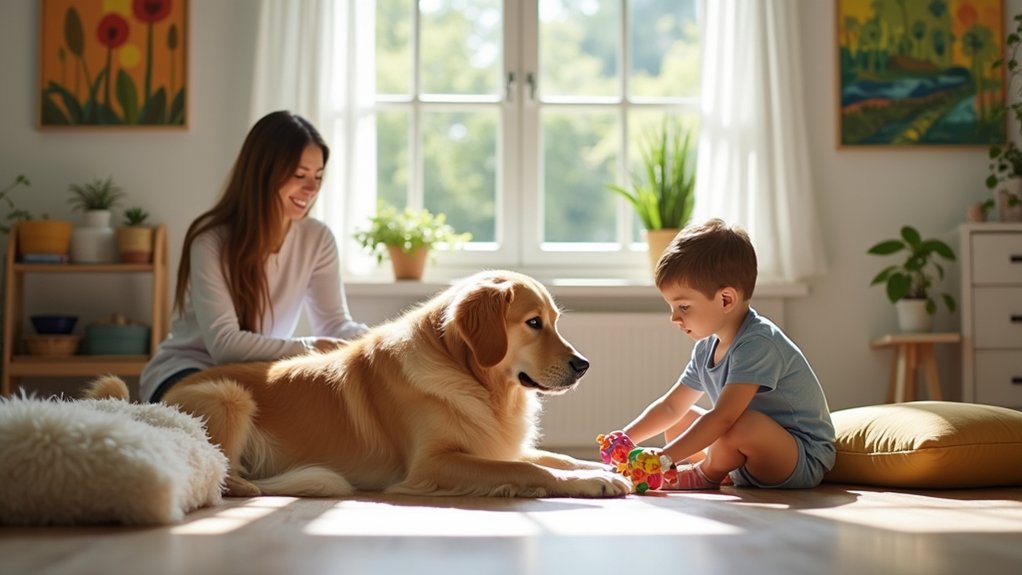

Leave a Reply